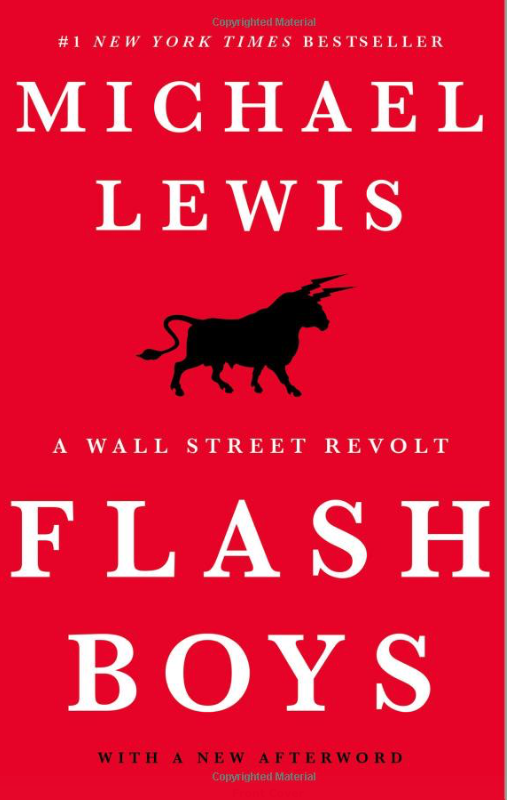
Flash Boys by Michael Lewis
This isn’t a typical review of self-development or self-growth book that I normally read and give my insights. However, upon recommendation from a friend, I decided to read this book and it did open my eyes and I learned several things which I would like to share with you. The book had some takeaways that I want to mention and see if it provides some new perspectives for you. So, technically this fits in the self fluency category.
Brief intro of Michael Lewis
Michael Lewis is a writer and a financial journalist. He has written books centered around the financial industry and some of the events that transpired recently, usually as vocal critic. Some of his books have been made in to movies. Moneyball and The Big Short are the movies you may have watched or recognize. In Moneyball, he criticized the stats and methods used by teams are outdated and relic of the past. With The Big Short, which dives in to the cause of the housing bubble and the 2008 financial crisis, he had a field day pointing out the irresponsible behavior by many firms and organizations.
As always with any critical statements, detractors will voice their side of the story and point out incorrect statements. This is all fine because it is always good to hear both sides of the story and it is up to the informed reader to formulate an opinion of their own. This is important because The Flash Boys is also very critical and controversial and has their own detractors. However, the story does shine a light on something, at least I was very little aware of. It did educate me and hope it gives you some new insights as well.
Introduction
The entire book is well written and is narrated like a fictional story or movie. Michael introduces stories and characters that all seem disconnected but as the book goes on, they all converge to tell the same plot.
The book starts with construction crew digging tiny tunnels under the ground that seem to serve no purpose. They are digging through mountains rather than going around them and going under riverbed. The crews have no idea of the purpose because of secrecy. Eventually, the tunnel is completed from Chicago to New Jersey with the sole purpose of housing fiber optic cables.
Then Michael introduces key characters in the book such as Brad Katsuyama. He is an employee of Royal Bank of Canada and notices odd behavior in the bid/ask process of trading stocks around 2007. Brad’s quest to find the cause of the odd behavior starts the journey where Brad meets different players that had a hand in causing this odd phenomenon.
Central plot of the book
The fiber cable between Chicago and New Jersey created few millisecond roundtrip between the Chicago Mercantile Exchange and the stock exchanges in New Jersey. Data centers were built near the stock exchange data centers for proximity advantage. Basically the rise of computer trading and the passage of Regulation National Market System (Reg NMS) created a new kind of traders called High Frequency Traders (HFT).
https://en.wikipedia.org/wiki/Regulation_NMS
These new type of traders are not your typical traders. They do not have any strategy, they do not research companies to buy or sell, they do not even hold any positions by the end of the day. Their only reliance is being the fastest to get to the exchanges. Using proximity, HFT can execute millisecond or even microseconds faster than investors looking to buy stocks. They can look at the order and buy stocks before the investor can and sell at a higher price to the investor than the investor’s initial bid. This is called electronic front running. This method blindly rips off investors such as big institutional investors such as mutual funds and pension funds who handles general public’s money.
Michael Lewis also describes rebate arbitrage and slow market arbitrage as other methods used by HFT to deprive investors of fair market prices of stocks. Slow market arbitrage is where HFT arbitrages minute price differences of stocks between various exchanges. Rebate arbitrage involves HFT activity that attempts to capture liquidity rebates offered by exchanges without really contributing to liquidity.
Although HFT seem to be the focal point of this new type of financial shenanigans, Michael says they are not the sole actors. Financial institutions such as Goldman Sachs, Credit Suisse and others who are supposed to be protecting the investors are complacent with using dark pools and allowing HFT on them. Exchanges allowed HFT to trade in close proximity to gain the speed edge. Each party had their own financial incentives for this motivation over their retail and institutional investors whom they are supposed to serve and protect.
However, not all were driven by financial motivations. Brad Katsuyama discovered all this and has met many people along the way. He and his team found a calling to help the people who were unknowingly being victimized. These people left their stable, cushy jobs and salary to start out on a new venture where probability of success would be almost non-existent. They started a new exchange, IEX, that would prevent the edge that HFT has so everyone can trade at fair price. They had a tough hill to climb as they were competing with other exchanges that did not have this restrictions. So most financial institutions were motivated financially to use the other exchanges rather than IEX.
IEX would struggle in the beginning with no financial firm participation. However, some had change of heart and starts to use IEX to trade. Michael pointed out Goldman Sachs started it first and speculate on reasoning why they may have. IEX still exists today and has about 2.3% of total trading volume.
Thoughts and takeaways
The book was very entertaining in the way Michael narrates it and very educational. The author did the research very thoroughly and laid it out easily for most readers to understand. Now with any books like this, detractors will come out and point out inaccuracies or defend their point of view. I admit, I have not researched the other point of view to give my take on it.
The main takeaway is, no matter what industry, sector, or company, there will be examples of greed and nefarious behaviors done legally by some loophole. It is great to see that there are people out there fighting the good fight while risking their financial and personal well being. Michael lists many names that truly need to be recognized and I encourage you to read the book and also learn something new in the process.
I did self-reflect after I read this. Can I do something like this? Can I risk everything – family, finance, time and energy to fight for something that most people do not even know that they are being wronged? I would say this is very hard to do even under right timing and circumstances. Family that supports you, financial stability to take the risk and the willpower to overcome all struggles is a rare combination to have at the right time. I have to admire Brad and his team to rise above it all even without the right conditions.
If you read this book or any of his other books, please leave a comment on your thoughts.
Michael Lewis books on Amazon
Flash Boys: A Wall Street Revolt
The Big Short: Inside the Doomsday Machine
Moneyball: The Art of Winning an Unfair Game
The Premonition: A Pandemic Story




